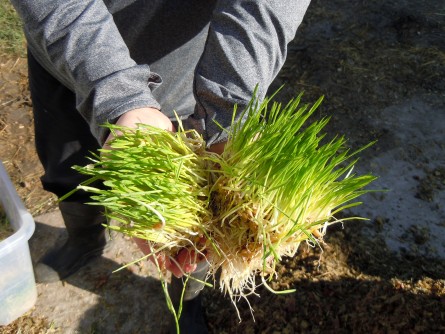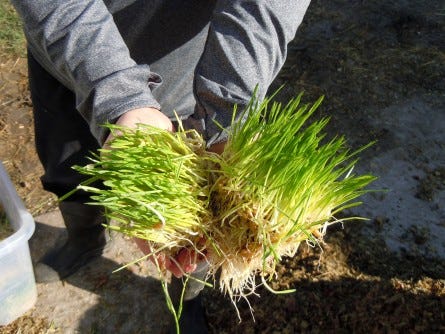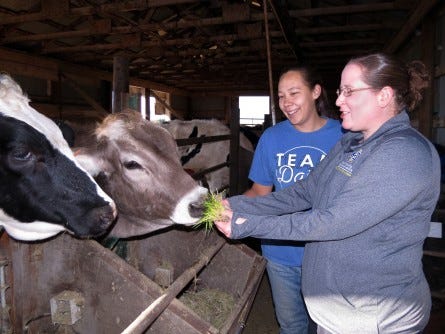Hydroponic feed like sprouted barley, grown indoors without soil, can provide livestock with fresh forage year-round.
December 7, 2016

Sprouted barley grown indoors without soil can provide livestock with fresh forage year-round, but few scientific studies have been done on these hydroponic feeds, according to South Dakota State University (SDSU) assistant dairy science professor Jill Anderson.
She and doctoral student Rhea Lawrence are evaluating the effect of integrating hydroponic feed into the diets of dairy heifers and lactating cows.

Hydroponic feed, such as this sprouted barley, grown indoors without soil can provide livestock fresh forage year-round. South Dakota State University dairy scientists are evaluating the new feed as part of a mixed ration for dairy heifers and lactating cows. Credit: South Dakota State University.
“This feed is pretty palatable. Both heifers and lactating cows tend to sort for it, even though we try to mix it in,” said Anderson, whose research focuses on ruminant nutrition. A six-week feeding trial for 20 lactating dairy cows, which was completed in early July, focused on milk production, while a 12-week feeding trial for 24 dairy heifers examines growth performance.
The research is supported by HydroGreen Global Technologies, which delivered sprouted barley each day to the SDSU Dairy Research & Training facility during the feeding trials.
Most of the information on hydroponic feeds, in general, is anecdotal, according to Anderson. “Not many controlled studies with two treatment groups have been done. That’s why (Hydrogreen) came to us for independent verification regarding the new feed,” she said.

South Dakota State University doctoral student Rhea Lawrence, left, and assistant dairy science professor Jill Anderson will evaluate the growth of dairy heifers fed sprouted barley as part of a total mixed ration. Credit: South Dakota State University.
For half of the animals in each study, the researchers replaced a portion of the ground corn and soybean meal in a typical diet with hydroponic feed. The researchers performed a lab analysis on the feed, taking out the moisture and calculating the other nutrients. “Then, we take it back to the farm and recalculate it on an as-fed basis,” Anderson said. That substitution amounted to 8% of the ration — figured on a dry matter basis — for the lactating cows and 14% for the heifers.
Milk production and profile
Lactating cows typically eat about 100-150 lb. of a total mixed ration, Anderson explained. The cows in the treatment group consumed 20-30 lb. of hydroponic feed. Feed intake for both groups was similar on a dry matter basis.
“Preliminary results show that lactating cows on hydroponic feed produced similar amounts of milk,” Anderson said.
However, there were weeks in July, during the hottest parts of the summer, when the results were different. These will be analyzed along with the environmental conditions, Lawrence explained.
Cows on hydroponic feed also produced milk with the same fat and protein content levels as the control group.
When the researchers asked a group of 25 volunteers to taste the milk, Anderson reported, “They couldn’t tell the difference; there were no off-flavors from the hydroponic feed.”
The researchers will also analyze the milk's fatty acid composition to "look at conjugated linoleic acid, omega 3 (and) omega 6 in the milk fat,” Anderson said.
In addition, the researchers took fecal samples to measure total tract digestion of nutrients, and they took blood samples to look at metabolic profiles, which indicate how the cows were partitioning energy during the trial, Anderson explained.
“It all relates back to feed efficiency and nutrient utilization,” she said. “We think hydroponic feed should encourage rumen health and better pH.”
Maintaining a 6.0 pH in the rumen helps the cow’s digestive system break down the feed and "keeps the microbes happier. If there are large fluctuations, those microbes don’t work as well,” Anderson noted.
Evaluating heifer growth
Each dairy heifer began the feeding trial at six months old and completed it at nine months old. To do this, the researchers staggered the trial start dates based on the heifer’s age.
The heifers consumed 30-40 lb. per day of a total mixed ration, and the treatment group was eating 10-15 lb. of hydroponic feed per day.
To evaluate growth performance, Lawrence documented bodyweight and took body frame measurements, including hip and wither height, every two weeks. “We want them to gain bodyweight, but we also want them to get tall,” she explained.
The feeding trials for the last group of heifers concluded in November, and the researchers have begun analyzing the data and completing the laboratory analysis.
The dairy heifer research can lay some groundwork for future studies using hydroponic feed for other growing animals, such as beef cattle and sheep, according to Anderson. “We should get some baseline results that can then be applied to other livestock species.”
You May Also Like

.png?width=300&auto=webp&quality=80&disable=upscale)

